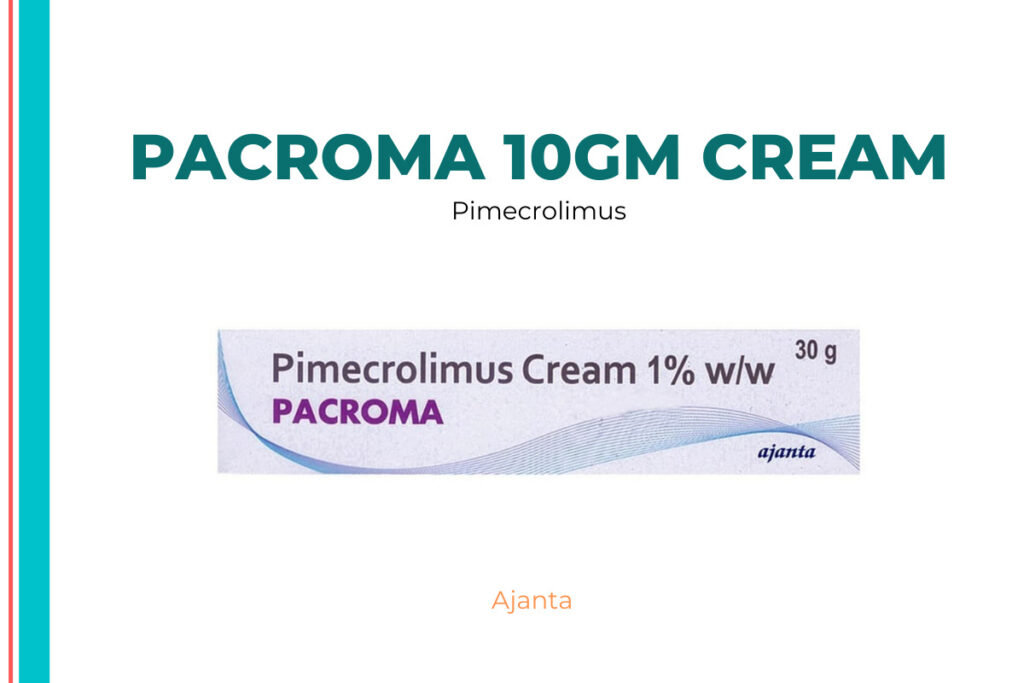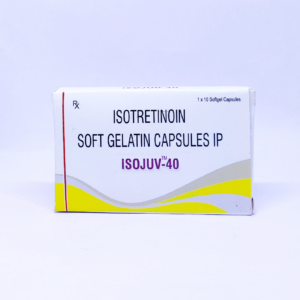Pacroma 1 percent Cream 10 gm
Pacroma 1 percent Cream 10 gm belongs to the ‘immunosuppressant’ class of dermatological preparations, which are primarily used to prevent allergies such as swelling, itching, redness, heat, and discomfort produced by specific skin diseases like dermatitis (itchy, swelling of the skin) and eczema (itchy, cracked, swollen or rough skin). Eczema is a skin ailment that causes inflamed, itchy, cracked, and rough patches of skin. Dermatitis is a skin ailment that causes swollen, reddish skin to become itchy and dry, as well as a rash.
Pacroma 1 percent Cream 10 gram is made up of Pimecrolimus works by preventing the immune system from creating eczema-causing chemical compounds. Chemical compounds are released routinely when the skin reacts to allergens of any kind. It works inside the skin cells to generate the inflammation, redness, and itching that eczema is known for. Swelling, itching, redness, heat, and pain caused by skin issues such as eczema or atopic dermatitis are treated with Pacroma 1 percent Cream 10 gm (itchy, cracked, swollen or rough skin).
Pacroma 1 percent Cream 10 gm is available as a topical (for use on the skin) cream. Depending on your medical condition, your doctor will recommend the proper dose. Pacroma 1 percent Cream 10 gm should not come into contact with your nose, mouth, or eyes. If Pacroma 1 percent Cream 10 gm unintentionally comes into contact with these places, thoroughly rinse with water. Burning, irritation, stinging, and redness at the application site are common adverse effects of Pacroma 1 percent Cream 10 gm. The majority of these Pacroma 1 percent Cream 10 gm side effects do not require medical care and will go away over time. Please visit your doctor if the side effects persist or worsen.
Please inform your doctor if you are allergic to Pacroma 1 percent Cream 10 gm or any other drugs. If you are pregnant or breastfeeding, you should seek medical advice before taking Pimecrolimus. Pacroma 1 percent Cream 10 gm should not be used in excess of the recommended doses or for an extended period of time since it may create side effects. When using Pacroma 1 percent Cream 10 gm, avoid drinking alcohol. It can make your skin flushed or red, and make you feel hot (especially on your face). Before using Pacroma 1 percent Cream 10 gm, tell your doctor if you have a weakened immune system (immunocompromised), erythroderma (redness of almost the entire body), Netherton’s syndrome (a disorder that affects the skin, hair, and immune system), skin malignancies (tumors), or skin infections (including chickenpox or herpes).
Atopic dermatitis uses Pacroma 1 percent Cream 10 gm (eczema)

Medicinal Advantages
Pacroma 1 percent Cream 10 gram is made up of Pimecrolimus belongs to a class of anti-inflammatory drugs known as topical calcineurin inhibitors. It is used to treat atopic dermatitis, a kind of skin irritation (eczema). It works by preventing the immune system from creating chemicals that could cause eczema. Chemical compounds are released routinely when the skin reacts to allergens of any kind. It works inside the skin cells to generate the inflammation, redness, and itching that eczema is known for. Swelling, itching, redness, heat, and pain caused by certain skin diseases such as eczema or atopic dermatitis (itchy, cracked, swollen, or rough skin) in children (aged 2 years and up), teenagers, and adults are treated with Pacroma 1 percent Cream 10 gm. When used to address early indications and symptoms, it can be quite effective. Pacroma 1 percent Cream 10 gm can help prevent flare-ups from becoming severe.
Use Instructions
1 percent Pacroma Cream The 10 gram is only to be used externally. Apply a thin layer of Pacroma 1 percent Cream 10 gm to the clean and dry affected region as directed by your doctor. Pacroma 1 percent Cream 10 gm should not come into contact with the nose, mouth, or eyes. If Pacroma 1 percent Cream 10 gm unintentionally comes into contact with these places, thoroughly rinse with water. If your hands are not the affected area, wash your hands before and after applying Pacroma 1 percent Cream 10 gm to prevent infection.
Store in a cool, dry location away from direct sunlight.
Pacroma 1 percent Cream 10 gm Side Effects
Irritation is mild.
Redness of the skin
a burning sensation at the application place
Drug Recommendations
Pimecrolimus should not be used on parts of the skin where a viral infection is active, such as cold sores (herpes simplex) or chickenpox. Pimecrolimus may raise your chances of getting a serious herpes simplex skin infection (eczema herpeticum). As a result, if you get painful sores on any part of your body, see your doctor right away. If you are pregnant or breastfeeding, you should seek medical advice before taking Pimecrolimus. Pimecrolimus should not be given to children under the age of two. Pimecrolimus should not be used on open wounds, sunburned, irritated, or dry skin. If your doctor advises it, do not cover or wrap the treated region with a bandage since it may cause injury. Topical Pimecrolimus should not come into contact with the nose, mouth, or eyes since it can irritate them. If Pimecrolimus comes into touch with these locations by mistake, thoroughly clean with water. Avoid smoking or going near bare flames since Pimecrolimus causes the fabric (bedding, clothing, and dressings) to catch fire and burn readily. Please consult your doctor before starting Pimecrolimus if you have a weakened immune system (immunocompromised), erythroderma (redness of practically the entire body), Netherton’s syndrome (a disorder that affects the skin, hair, and immune system), or skin malignancies (tumors). While taking Pimecrolimus, avoid excessive sun exposure, sun lamps, and tanning beds. If you go outside after applying Pacroma 1 percent Cream 10 mg, wear loose-fitting clothing, use sunscreen, and spend as little time in the sun as possible.
Interactions Between Drugs
Interactions between drugs: Pimecrolimus may interact with antifungals (fluconazole, itraconazole, ketoconazole), calcium channel blockers (diltiazem, verapamil), antiulcer drugs (cimetidine), antibiotics (clarithromycin, erythromycin, troleandomycin, metronidazole), androgenic hormones (danazol), immunosuppressants (cyclosporine), HIV protease inhibitors (indina (birth control pills).
Pimecrolimus and Alcohol Interaction: Pimecrolimus and alcohol may interact. As a result, avoid drinking alcohol while taking Pimecrolimus.
Drug-Disease Interaction: Before using Pimecrolimus, tell your doctor if you have skin malignancies or pre-cancers, Netherton’s syndrome, skin infections (including chickenpox or herpes), or a weak immune system.
Safety Suggestions
ALCOHOL
When taking Pimecrolimus, avoid drinking alcohol. It can make your skin flushed or red, and make you feel hot (especially on your face).
PREGNANCY
Pimecrolimus is a Category C pregnancy medicine that should only be administered to a pregnant woman if the benefits outweigh the dangers.
BREAST FEEDING
Pimecrolimus is not known to be excreted in human milk. It is only given to breastfeeding women if the doctor believes the advantages outweigh the hazards. If you need to apply the cream to your breasts, wait until after you’ve given a feed to do so.
DRIVING
Pimecrolimus has no effect on your ability to drive or operate machines.
LIVER
Pimecrolimus should be used with caution, especially if you have a history of liver illness. Your doctor may alter the dose if necessary.
KIDNEY
Pimecrolimus should be used with caution, especially if you have a history of kidney illness. Your doctor may alter the dose if necessary.
No habit formation
Advice on Diet and Lifestyle
Apples, cherries, broccoli, spinach, and blueberries are high in quercetin (a flavonoid).
Probiotic-rich foods aid in the development of the immune system’s resistance to allergies.
Foods such as dairy, soy, eggs, and nuts should be avoided if you have allergies.
Foods high in sugar should be avoided because they can aggravate inflammation.
Fruits, vegetables, whole grains, healthy fats, and seafood should all be part of your diet.
It would be beneficial to reduce stress and keep a normal sleep pattern.
Keeping your hands away from harsh soaps, detergents, and rough textiles.
When taking a bath, use mild soap and opt for a warm bath. On your skin, stay away from harsh products.
To avoid infecting the affected region, do not scratch or pick at it.
Recommendations
Pimecrolimus should not come into contact with your nose, mouth, or eyes. If Pimecrolimus comes into touch with these locations by mistake, thoroughly clean with water.
You may need to stop taking Pimecrolimus before getting any immunizations if you have severe eczema. If this is necessary, your doctor will be able to tell you.
If your eczema does not improve after two weeks or worsens, see your doctor.
Pimecrolimus should not be used on parts of the skin where a viral infection is active, such as cold sores (herpes simplex) or chickenpox.
Unless your doctor tells you otherwise, do not take Pimecrolimus for an extended period of time without taking a break.
Additional Information: This item is non-refundable.
Glossary of Diseases and Conditions
Eczema (atopic dermatitis) is a skin inflammatory illness marked by red, itchy rashes. Allergies are the most common cause of eczema. Rashes can be caused by soaps, dyes, chemicals, or other irritants. Eczema flare-ups can be avoided by avoiding the triggers. Dermatitis is a skin condition that is characterized by dry, itchy, or puffy skin.
FAQs
1 percent Pacroma Cream Contains 10 gm Immunosuppressant Pimecrolimus is a drug that suppresses the immune system. It works by reducing your immune system’s response. It is used to treat a kind of skin inflammation known as atopic dermatitis (eczema).
As long as your doctor has prescribed Pimecrolimus, you should take it. Please visit a doctor if the disease persists or worsens after 1 week of treatment with Pacroma 1 percent Cream 10 gm.
Pimecrolimus should only be used on the face if your doctor recommends it, and it should not be used on the face for more than 5 days at a time because the skin on the face thins readily. Avoid using bandages or dressings on your face.
Pimecrolimus is only to be used externally. Avoid coming into touch with your eyes. Rinse with water if Pimecrolimus gets into your eyes, nose, mouth, or vaginal area. While using Pimecrolimus, do not apply a bandage or dressing to the afflicted region unless your doctor advises you to. Pimecrolimus should not be used on sunburns, open wounds, lesions, or blisters. If you have shingles, chickenpox, or measles, don’t contact anyone else. If you come into contact with someone who has them, please call your doctor right once since you will need special care if you have never had these conditions.
Pimecrolimus has been shown to be safe and effective in both young and elderly people. Pimecrolimus can thus be used to treat skin infections in the elderly.
Covering the treated region of skin with bandages or dressings is only indicated if your doctor recommends it; otherwise, it may raise the chance of side effects.








Leave a Reply
You must be logged in to post a comment.